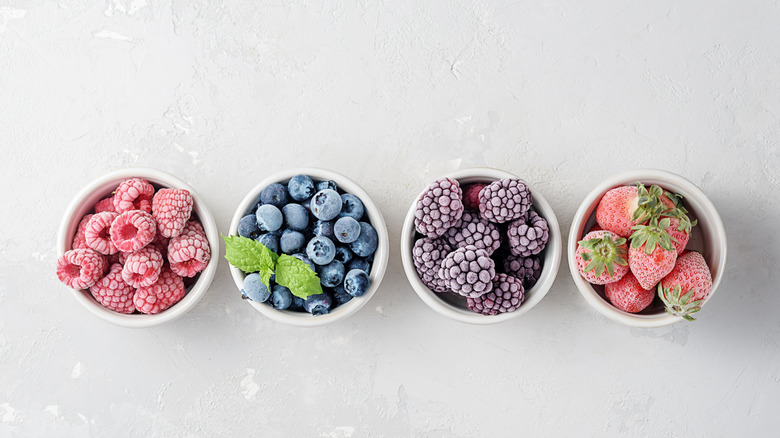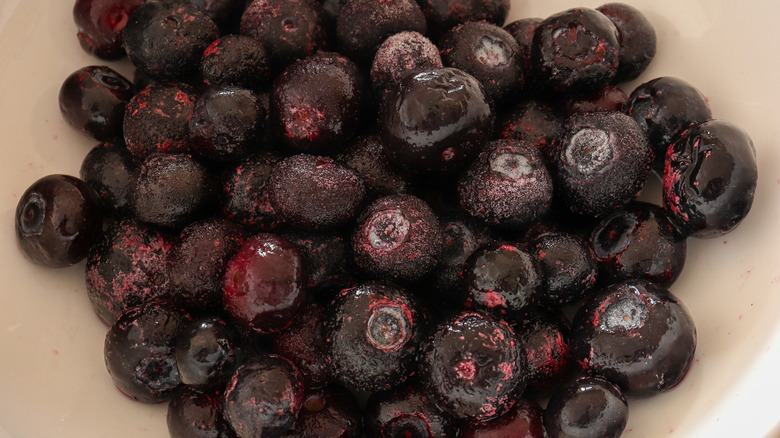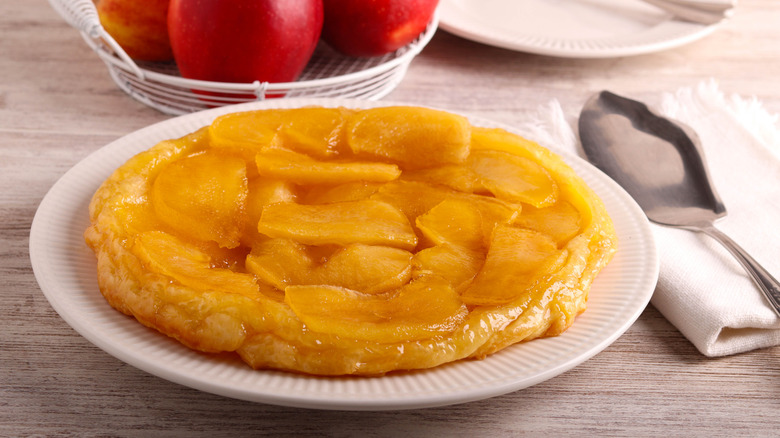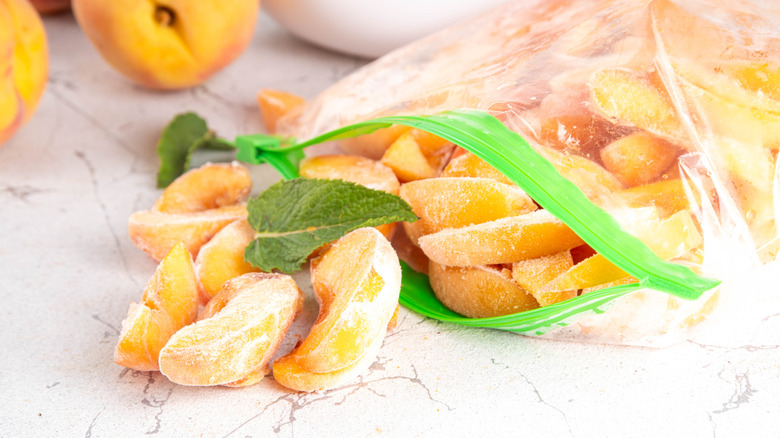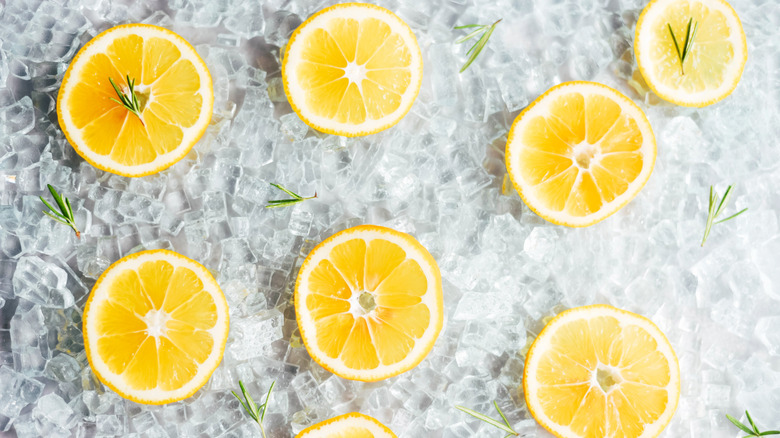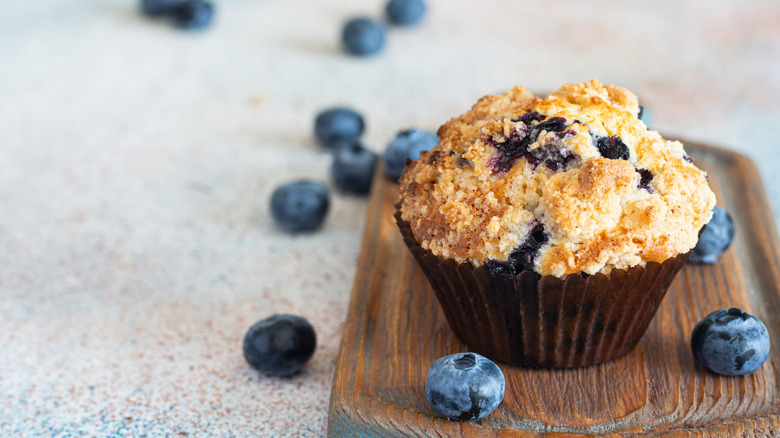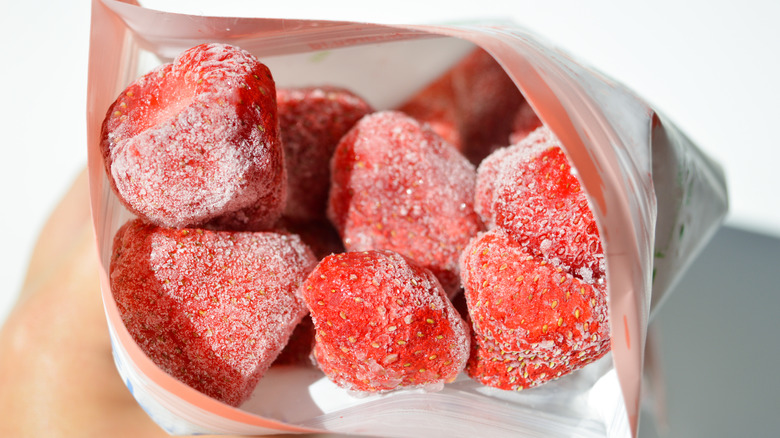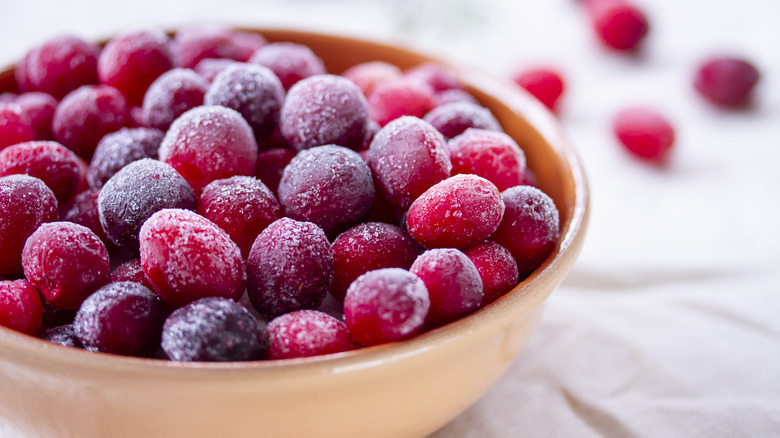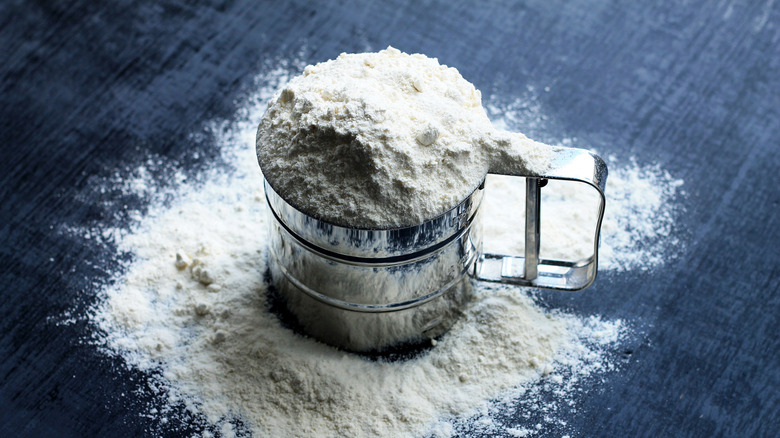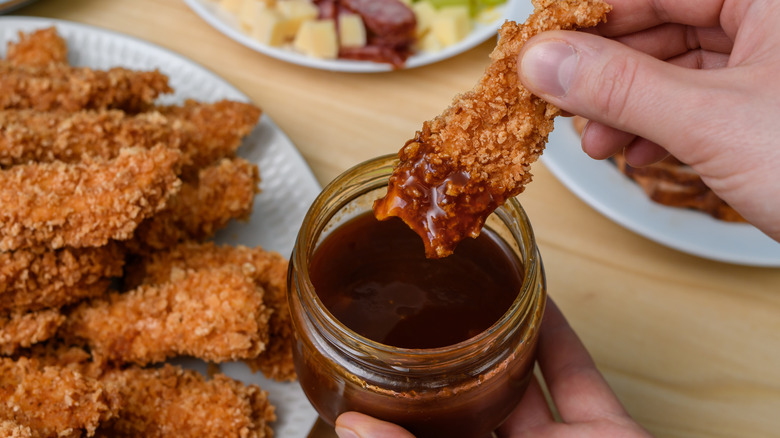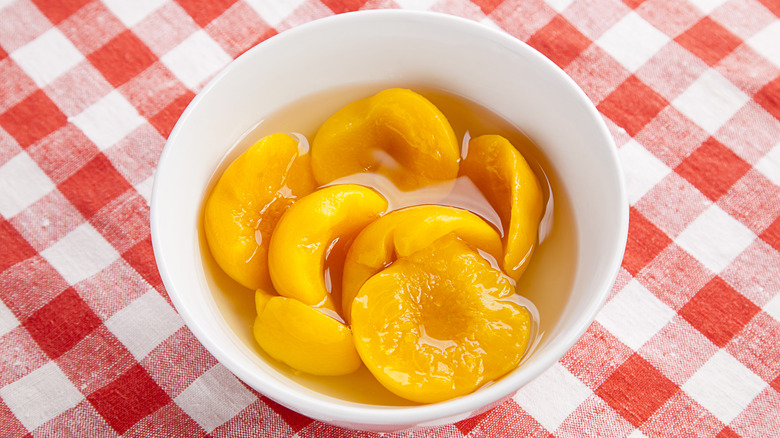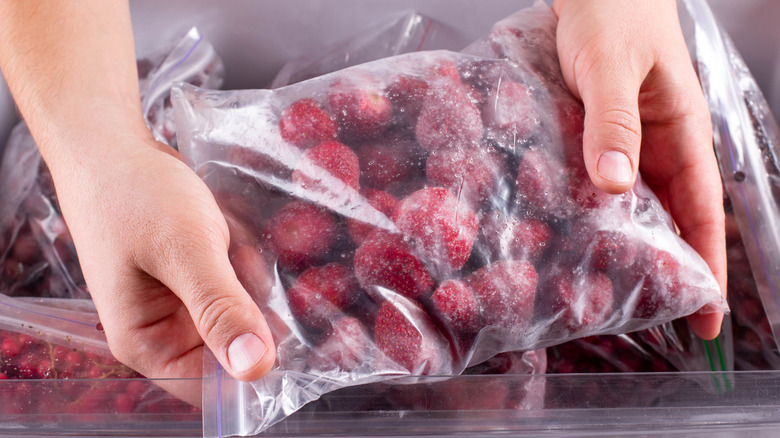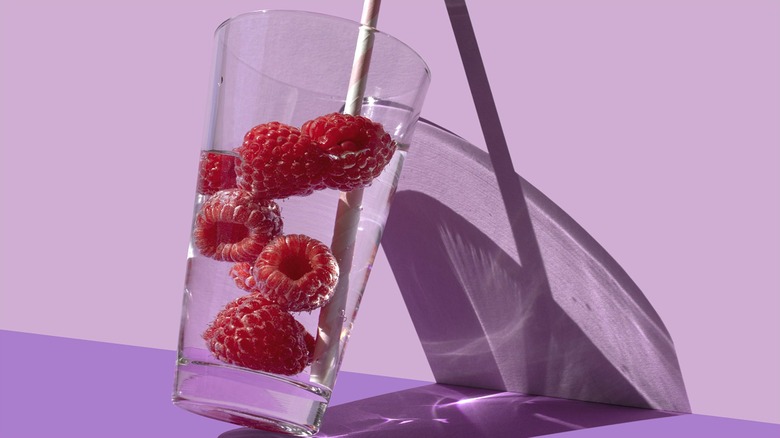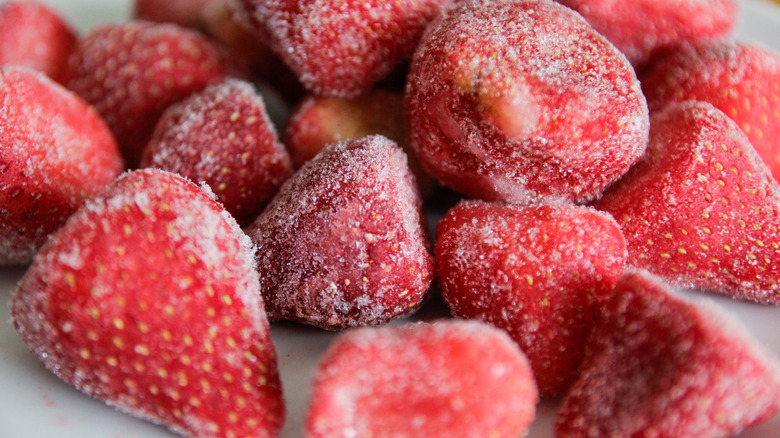14 Mistakes Everyone Makes With Frozen Fruit
Frozen fruit seems easy, right? It's just fruit that's been ... frozen. How hard can it be to get right? Well, as it turns out, surprisingly hard. Frozen fruit can be somewhat of a temperamental ingredient, and although you can freeze plenty of fruits and do loads of interesting things with them, things can quickly go awry. Most of the time, we treat frozen fruit exactly like its fresh counterpart, but freezing it changes its texture and alters how its moisture is released. This can quickly lead to mistakes in the kitchen and ruined dishes, without us realizing it.
Using frozen fruit can also go wrong not just because of its consistency, but because of its flavor. A lot of people have a habit of treating all types of frozen fruit like each other, and throwing whatever we have in the freezer in our recipes. But just like fresh fruit, different types of frozen fruit vary considerably in their taste notes. Plus, we can also quickly forget that frozen fruit can be used in way more ways than just smoothies and pies. Ready to improve your frozen fruit game for good? We've got you.
1. Mistake: Assuming you can always swap frozen fruit for fresh
Frozen and fresh fruit are two sides of the same coin, but those sides are very different. When you freeze fruit, its consistency changes for good. Most fruit has a very high water content, and that water freezes and expands inside the fruit itself, making it softer than the fresh kind. This unfortunately means that using frozen fruit in the same way as fresh fruit will sometimes give you a vastly different result, and may be inappropriate for your needs.
When using fruit as a dessert garnish, for example, you should always use the fresh kind. Frozen berries may be firm when they're still in their frosty state, but when they thaw they'll soften and drip juices all over your cake or pastry. If you're having fruit as a snack, you'll probably also want to use the fresh version instead of the frozen one, as the same problem will occur. However, the good news is that there are plenty of situations where you can swap the two interchangeably. You just may have to adjust your cooking times slightly, but the end result will be nearly exactly the same.
2. Mistake: Thawing your frozen fruit — or not thawing it at all
To thaw or not to thaw? That is the question — when it comes to frozen fruit, at least. While you don't have to cook frozen fruit, there are some situations where you might want it to be soft before you use it, and other situations where you'll need it to stay hard and cold. Unfortunately, a lot of people struggle with which state to use in which recipe, leading to a lot of disappointments.
Generally speaking, it's best to keep frozen fruit frozen when you're baking with it. If you thaw it before use, then it will only get softer and mushier as the food cooks, and you'll lose any texture it may have once had. By that logic, you should also keep it frozen if you're adding it to sauces where you want it to keep its shape, like coulis, and toss it in at the very end so it thaws without disintegrating.
Conversely, you should normally thaw fruit when you're planning on eating it on its own or as a topping. Crunching through hard pellets of frozen fruit on your morning yogurt or granola won't be particularly pleasurable. To do this, you can either pop them in the microwave or leave them out at room temperature for a while.
3. Mistake: Forgetting about the moisture content
When you're using frozen fruit, there's one major thing that trips almost everyone up: Moisture. Fruit doesn't magically gain additional moisture when it's placed in the freezer, but instead, the water that's naturally present in the fruit transfers from inside to outside when thawed. Unfortunately, this can cause big issues when you're cooking with it. If you forget that frozen fruit will add moisture to your dish when heated up, you can end up with a soggier result than you'd expect.
This is a particular problem when you're making dishes that rely on a certain level of dryness to maintain their structure and flavor, like cakes and pies. You generally won't need to change the recipes of these dishes to account for this extra moisture, but you will likely need to adjust your cooking times slightly. When using frozen fruit in an upside-down cake, for example, you might want to give your cake a little bit of extra time in the oven, so that all of that extra moisture is soaked up and cooked off. You may also want to think about how you construct your bake to allow for evaporation: Making a lattice pattern for your pie lid, instead of using a sealed dome, can help extra moisture dissipate and give you a firmer interior.
4. Mistake: Picking the wrong frozen fruit
Is all frozen fruit equal? Of course not. You wouldn't substitute fresh strawberries for fresh peaches in a cobbler and expect the same result, so why would you do the same thing with frozen ones? Unfortunately, way too many people do, and forget that frozen fruit isn't just some catch-all ingredient that gives some kind of fruity flavor. Using the wrong one will seriously alter the flavor of your dish.
It's not just flavor you need to consider either, but texture too. Substituting a frozen fruit with a different type can leave you with a softer consistency than you'd like, with peaches being a particular culprit. "Peaches do tend to break down some and can get mushy, so they may be better in something that doesn't require a plump fruit structure, for example, a glaze for a cheesecake," says Kara Lynch, a food safety educator and registered dietitian, to Mashed. The same can be said for some types of frozen berries or frozen cherries, which tend to disintegrate pretty quickly.
5. Mistake: Assuming all fruit freezes equally well
Generally speaking, freezing fruit is worth the hassle. Fruit perishes very quickly, so freezing it at home is a great way to preserve it for way longer and avoid food waste. However, you shouldn't assume that all of the fruit in your bowl will freeze equally well. The ability to freeze fruit successfully depends largely on the fruit in question's individual structure, and fruits with an especially high water content or a pulpy consistency can struggle in your freezer. This means that fruits like apples and watermelons can be a poor choice to freeze, as when you defrost them they can break down beyond saving.
Citrus fruits can also struggle in the freezer, with types like watermelons, lemons, limes, and oranges potentially breaking down too much when thawed. However, what does freeze successfully from these types of fruit is their zest. Keeping lemon zest and using it later down the line by freezing it into ice cubes is a fabulous way to add an immediate citrus note to your food, and to cut down on food wastage.
6. Mistake: Over-mixing frozen fruit into recipes
No one wants a clumpy cake, with its ingredients all stuck together — and most of us know that the solution to this is mixing things well. Unfortunately, when you're working with frozen fruit, there's a balance to be found. If you over-mix frozen fruit into your recipes, you'll increase the likelihood of it breaking down and becoming mushy. Not only will this leave you with a dish that doesn't have those delightful pops of fruity flavor, but it will also smear whatever fruit you're using throughout your dish, dyeing it a different color.
This can be particularly likely to happen with frozen berries, which can be a bit more delicate. If you over-mix blueberries into muffins, for example, you'll stain the batter a blue-purple color and not have any of those big berry chunks we all want. The solution? Work quickly and carefully. Gently mix your berries until they're fully combined with the batter, and then stop. Don't be tempted to thaw them, either, as this will just release even more blueberry juice into the batter. If you start to see blue streaks through your muffin mix, put the spoon down.
7. Mistake: Freezing overripe or underripe fruit
Freezing fruit is a great way to extend its lifespan and reuse it another day. Plus, because it's so easy to do, a lot of people throw their produce into the freezer without a care in the world. However, before you do so, you need to eye the ripeness of your fruit. Commercial frozen fruit is usually picked and processed both when the fruit is in season and when it's at peak ripeness. This ensures that it's as delicious and nutritious as it can possibly be, and that it freezes well.
However, freezing fruit that's at either side of peak ripeness is an issue. Freezing underripe fruit will not make it any more edible, and it'll remain hard and chalky when you thaw it. Overripe fruit, on the other hand, tends to be mushier than when it's ripe — and that mushiness will mean that when it's thawed, it breaks down even more. As such, only freeze your fruit when it's ripe for the best results. That doesn't mean you have to throw away overripe fruit, though: You can purée it down into a paste or sauce, pop it in a Tupperware dish or Ziploc bag, and then throw it in the freezer. Because it's already in a liquidated state, you don't have to worry about it getting runnier.
8. Mistake: Blanching your fruit before freezing it
If you've ever tried your hand at freezing fresh vegetables, you'll likely know that most of them need to be blanched. This blanching process is key to their ability to last a long time in your freezer, as it deactivates the enzymes in your veggies, which stops them from deteriorating. So, it's only natural to assume that you should do the same with your fruit before you freeze it, right?
Wrong. In fact, you should avoid blanching your fruit before freezing it. This isn't because fruit doesn't have enzymes in it, but because applying high heat to pretty much any type of fruit will alter its flavor and texture way more than you'd like. The whole point of frozen fruit is that it's fresh, not cooked.
However, if you do want to make sure your fruit lasts for longer in the freezer, you can treat it in a different way. Adding ascorbic acid to fruit before freezing it can help to slow enzyme action. This acid will both stop it from browning or changing color, and from breaking down as quickly.
9. Mistake: Not adding flour to your frozen fruit
Cooking with frozen fruit can make your life much easier, but it also provides many of the same issues as cooking with its fresh counterpart. One example of this is how well it distributes through your baked goods. If you're adding frozen berries to muffins or cakes, they're just as likely to sink to the bottom of the batter as the fresh kind, leaving you with a clump of fruit mush at the base of your delicious dessert.
Sadly, too many people forget that just like fresh fruit, frozen fruit should be coated in flour before being added to the batter. This flour will help it suspend in the batter and not sink while it's being cooked, providing perfect distribution. Importantly, though, flour has another vital function for frozen fruit that doesn't affect fresh fruit as much. When you add flour to frozen berries, it prevents them from bursting and bleeding as easily. Your batter will remain a nice, consistent color and flavor, and you'll have more contrast between the dough and the berries.
10. Mistake: Only using frozen fruit in desserts
Frozen fruit is, of course, usually pretty sweet — and so it's only natural that it usually makes its way into our desserts. However, if you're not wielding its power for other, more savory foodstuffs, then you're missing out. Frozen fruit can add a pop of sweetness to savory items, and a pop of tanginess and acidity that doesn't feel as heavy or cloying as if you use vinegar. Plus, using fruit in place of sugar or acid gives you some added nutrition with these flavor notes.
One of our favorite ways to use leftover frozen fruit is in salad dressing. Instead of adding sugar to a vinaigrette or dressing, blend some frozen fruit and pour it in instead. The fruit will add a satisfying thickness to your dressing, and a sprightly, fresh flavor note that will meld well with the ingredients in your salad. Plus, you won't have to use as much vinegar or lemon juice. Alternatively, make a BBQ sauce with a sweet twist with some old frozen fruit, again by replacing some of the sweet and sour elements in your sauce with puréed produce. The bright notes of the fruit will give your meat a much-needed lift and good nuance.
11. Mistake: Assuming that frozen fruit has the same nutritional quality as other types
We all know that frozen fruit is nutritious, but what we're less aware of is how nutritious it is compared to other types. It's easy to just assume that a handful of fresh cherries, canned cherries, and frozen cherries have the same nutritional content, and we can swap them out interchangeably. Well, that's not quite true. In fact, frozen fruit may actually have more nutrients than both canned and fresh fruit.
When it comes to frozen fruit versus fresh fruit, the frozen version can sometimes take the lead on the nutrition front, thanks to being frozen at peak freshness. This locks in its nutrients immediately, whereas fresh fruit can continue to lose its nutrients as it wiles away time in the store and in your fruit bowl. Frozen fruit is also a way better buy than canned fruit for nutrition, thanks to both the nature of the canning process and potential additional ingredients. Canned fruit goes through a fairly intense heating process that can diminish its nutrients, whereas frozen fruit doesn't go through any heating before being frozen. Plus, canned fruit can often come packed in sugary syrups, which can significantly affect its nutritional quality.
12. Mistake: Forgetting to wrap up your frozen fruit
Like any other type of frozen food, frozen fruit won't last forever — and how you store it can affect its lifespan pretty considerably. Sadly, a lot of people treat their frozen fruit pretty badly. They rip open the bags it comes in, then toss it back in the freezer without wrapping it up tightly or sealing it properly. Then they're confused when, a few months down the line, it's covered in ice crystals and has a patchy appearance.
Well, that's because freezer burn has happened, folks, and it occurred because you didn't protect your fruit. When your frozen food is exposed to the dry air in your freezer, it can begin to dehydrate. This changes the surface of your food, making it look chalky and discolored. This can also be accompanied by that unpleasant "freezer" flavor. Because frozen fruit is so high in moisture, it's more likely to develop freezer burn than some other types of food. The solution is to protect your frozen fruit from the chilly winds of your freezer as much as possible. Wrap it up tight between uses.
13. Mistake: Not using frozen fruit as ice
One of the biggest mistakes we see with frozen fruit is not how people are using it, but how they're not using it. In our opinion, way too many folks out there that frozen fruit is probably the best substitute for ice that you can find. Not only is it cheap, but it manages to retain its coolness when plunged into a drink. It doesn't melt into your beverage and water it down, it doesn't really affect its flavor (although it can add a nice fruity twist to some drinks), and it can also be eaten as a snack when you're done drinking. What's not to love?
You can pop frozen fruit in a glass of cold water for a refreshing summer drink, or you can use it to cool down a cocktail. Try putting a few frozen blueberries into a gin and tonic, or blending frozen fruit into a frozen margarita or a piña colada. Alternatively, skip the ice in your smoothie and use frozen fruit instead. By opting for fruit, you keep your smoothie thick and flavorful, and add extra flavor and nutrition to your drink.
14. Mistake: Forgetting that frozen fruit isn't always safe to eat raw
Your frozen fruit is probably one of the healthiest things in your deep freeze, but its nutritional content doesn't always mean that it's safe. Like other types of fresh produce, frozen fruit is prone to contamination from various sources, and in the past has caused some worrying outbreaks of foodborne illness. For example, in 2023 a host of illnesses and hospitalizations caused by hepatitis A were traced back to frozen strawberries sold under several different brand names in the United States.
The problem is that a lot of people assume that frozen fruit is somehow sterilized, but that's not quite the case. Unlike frozen vegetables, frozen fruit isn't blanched before it's frozen. Although the fruit is washed before it's bagged, it can still carry the risk of contamination, as freezing food doesn't kill off bacteria but instead just deactivates it until it's thawed. If you want to be super safe, it can be a good idea to wash your frozen fruit before eating it at home.
Static Media owns and operates Daily Meal and Mashed.

